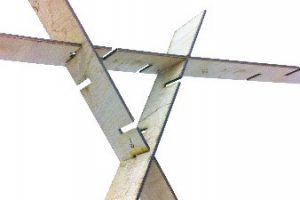
Reciprocal structures are composed of mutually supporting rigid elements that are short with respect to the span of the entire structure. Although reciprocal structural systems have received significant interest among architects and engineers, they are not yet commonly employed in construction. The main reason for this non-adoption, is the complexity of conceiving a structure from a module to the global scale without adapting the structure’s final global shape. As a result, two approaches have emerged for the design of reciprocal structures. The first approach takes the module as primary building blocks and the final global form emerges as a result of the module’s properties. The second approach results from adjusting the module’s properties throughout the surface of the structure to fit its predefined global shape. This paper presents a complete design-to-construction workflow for reciprocal frames using a cell-based pattern algorithm. The developed parametric model explores geometry and patterning to adapt any module geometry to any free-form surface by adjusting the eccentricities between the modules. The resulting reciprocal structure is then analyzed and sized using finite elements. Finally, manufacturing layouts are generated and construction processes are discussed. The design-to-construction workflow was validated experimentally with the construction of a 5-meter diameter reciprocal hemispherical dome.
Y. Anastas, L. Rhode-Barbarigos, and S. Adriaenssens ‘Design-to-Construction workflow for cell-based pattern reciprocal free-form structures‘ , Journal of the International Association of Shell and Spatial Structures, vol. 56(2), pp. 159 – 176, 2016